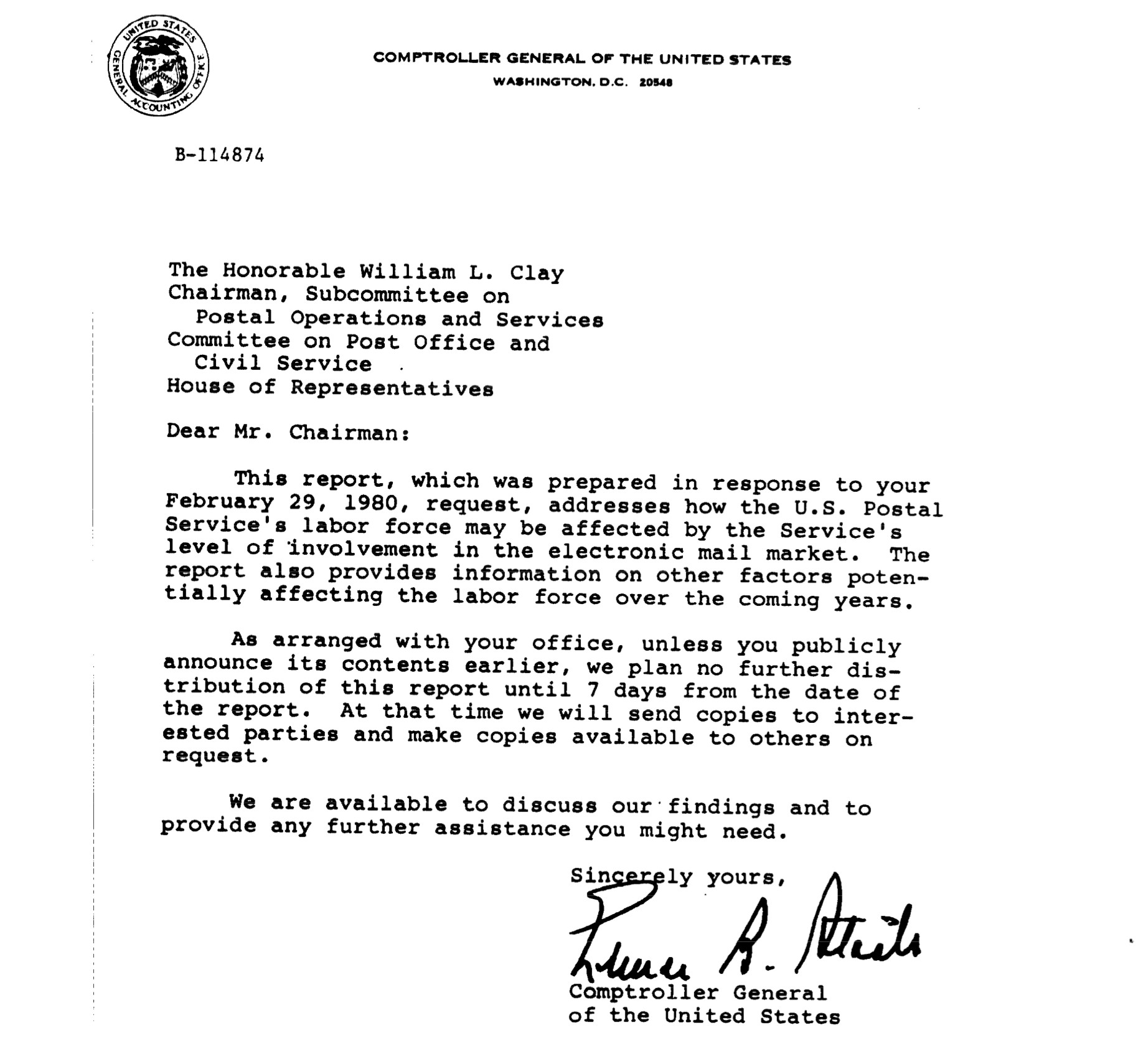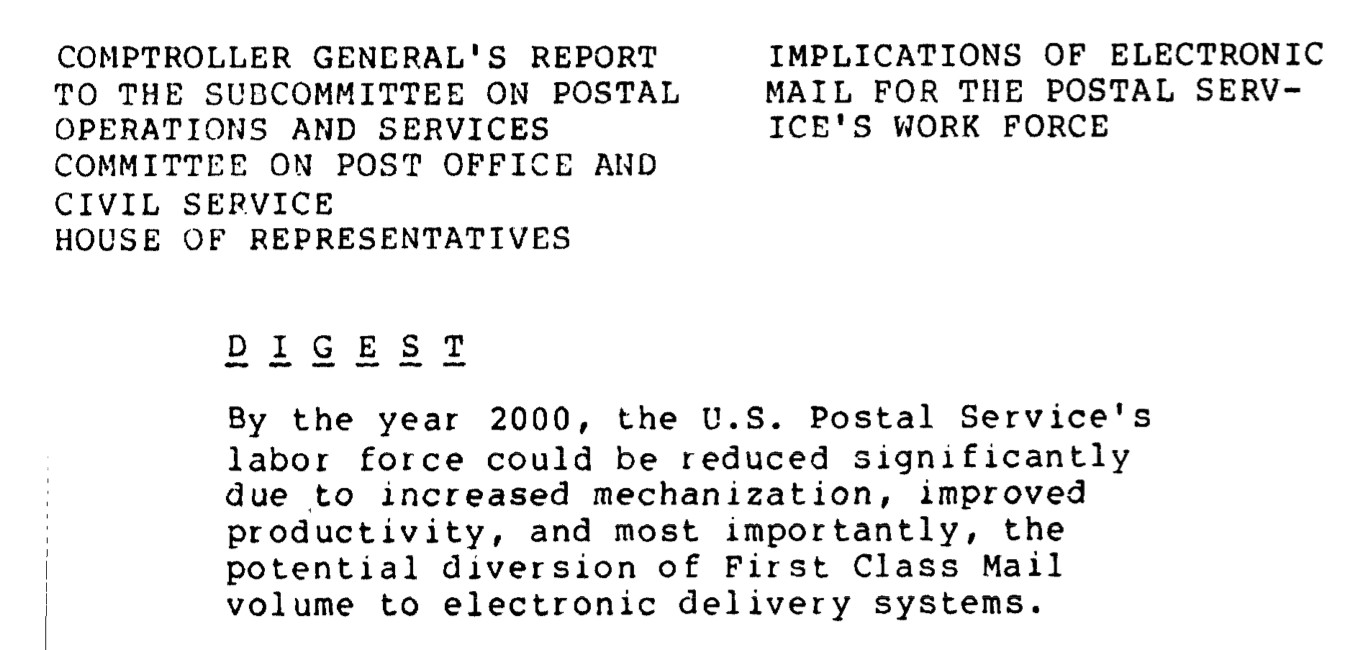Missing the Point – It’s way past the beginning of the end of the USPS
Fifty-three years ago, The Postal Reorganization Act of 1970 converted the U.S. Post Office Department, then a cabinet-level entity, into the independent agency we’ve known since then as the U.S. Postal Service. As an independent agency, it’s effectively a company owned and overseen by its board of directors, the federal government.
Turns out that 1970 is also a fairly good year to mark the birth of the Internet, the now-global, life-changing network over which you’re probably reading this op/ed. “As fate would have it,” which is what the narrator of Jay Ward’s “Rocky and Bullwinkle” would say, it would also mark the beginning of the end of the U.S. Mail as a government service. The new USPS didn’t realize at the time, but the inevitable privatization of the Postal Service was, as another great American would write, “blowin’ in the wind.”
Take a look at the letter and the opening paragraph of the summary (“Digest”) below it. They’re screenshots I took from a GAO (General Accounting Office) report entitled “Implications Of Electronic Mail For The Postal Service’s Workforce,” dated February 6, 1981. You may want to click on the screenshots to make them larger and easier to read.


Clearly, our government and the USPS have been contemplating the adverse impact of electronic mail delivery on our mail service for some time now. True, the effects of technology on our Postal Service have, undoubtedly, been much more severe than they anticipated sixty-plus years ago. The point is, it’s not as if Congress and USPS management didn’t see it coming or haven’t had time to adjust.
At heart, I’m a free-market guy.
President Lincoln advised us that “The legitimate object of government, is to do for a community of people, whatever they need to have done, but cannot do, at all, or cannot, so well do, for themselves – in their separate, and individual capacities. In all that the people can individually do as well for themselves, the government ought not to interfere.” I agree.
As you may know, I’ve written previous op/eds in my “Missing the Point” series arguing that it’s high time we privatized the US Postal Service. Not just because it is still refusing to replace the badly damaged, rusted, and wobbly Cluster Mailbox Unit that serves my cul-de-sac which should be reason enough. No. More importantly, I want us to turn over the U.S. Mail to the private sector because I don’t like independent agencies in general. And, more specifically, because non-government, competitive, for-profit companies will do a much better job providing the postal services we need, at substantially lower costs. They’ll give us superior, more useful mail services for well less than the $79.5 billion in operating expenses the USPS incurred in Fiscal 2022.
So, what might a private-sector mail service look like? I’ll start the conversation, but you should comment below this op/ed or email me your thoughts for the benefit of interested corporate players and Members of Congress who read the Baltimore Post-Examiner.
1. For one thing, multiple private sector providers would be motivated to offer their mail services at competitive prices. Notice that I said “multiple.” I do not recommend that the government authorize a single company to replace the USPS with a private-sector monopoly. No, no.
2. Nor do I suggest that we over-regulate the private sector mail service providers. Congress can define general objectives, but should otherwise leave it to the providers to make it happen. Set them free to compete with each other for the favor of their residential and business customers in the best and purest traditions of the American economy.
3. Rather than being required by law to subscribe to USPS mail services, consumers should be allowed to select from among various privately provided service packages that participating companies would advertise. Pay for the extra services your family or business needs. Don’t pay for the services you don’t want. It’s a remarkably simple free market option that the USPS monopoly doesn’t allow.
4. To make sure everyone can afford the new, we’ll call it “Basic Mail Service,” we’ll require that all private sector providers offer common programs for lower-income families.
5. First Class mail is the USPS’ second largest source of revenue behind “Shipping and Packages” which is the Postal Service’s leading revenue category. Unfortunately, since First Class mail’s historical high of 103.7 billion pieces it processed in Fiscal 2001, the Fiscal 2022 volume is down to 48.9 billion. …Why? Well, it’s a good bet that free email, texting and online billing and payments have had a lot to do with it.
In the private sector, first-class mail will become a rarely used and more expensive option. Maybe personal birthday and other holiday cards will have a special rate. I don’t know. Whatever. I’m sure the new mail companies will offer whatever special services make sense. And we’ll just have to find a better use for all those billions it’s costing us to handle first-class mail.
6. USPS revenues from “Shipping and Packages” are actually up, in part due to increased online sales by companies using the USPS to handle deliveries of some of their products. Next-generation mail service providers will provide these shipping services, but without the safety net of government subsidies if and when they lose money doing it.
7. To date, it has been assumed that the receipt, sorting, distribution, and delivery of the mail can only be accomplished by a single entity. We’ll call this “the public utility model,” but there’s no real basis for it. Amazon and UPS exist side by side as would much smaller, local and regional services, competing in some respects, cooperating when it makes sense. Without question, larger firms will have the advantage of their capital and infrastructure. Let the market figure this out for itself – subject to oversight by the FTC and Congress.
8. Standardized labeling and packaging, for all service providers, will be the rule, but some providers will no doubt offer special services at a price.
9. Almost nobody, no family or company, needs paper mail delivery six days a week. Not first-class mail. Not bulk, commercial mail. Private-sector mail services will offer basic once-a-week services. More frequent delivery will cost more.
If urgent delivery is necessary, such as for prescriptions, it’s a special service that should be reasonably priced and subsidized for lower-income families.
Regular, non-urgent mail will arrive weekly, on different days in different communities, in boxes containing all our mail for that week. No individual or even cluster mailboxes will be required. No mail US Postal Service personnel will be out there delivering the mail, mostly in small specially designed trucks, not in the way they’re doing it now.
10. USPS mailboxes and post offices will be removed and liquidated in favor of fewer, smaller mail stations – different stations for different service providers – inside retailers who bid for and subsidize these facilities – the way Kohl’s receives Amazon returns, but with more identifiable branding and structure.
Yes, we’re talking about a dramatic shift in the way mail service is perceived, from an outdated, overpriced government service to a multi-provider retail product. We’re going to be done with “mailing” documents and packages to being consumers of “document and small package shipping services” the way we buy everything else.
What do you think?

Les Cohen is a long-term Marylander, having grown up in Annapolis. Professionally, he writes and edits materials for business and political clients from his base of operations in Columbia, Maryland. He has a Ph.D. in Urban and Regional Economics. Leave a comment or feel free to send him an email to [email protected].

